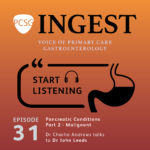Pancreatic Conditions Part 2 – Malignant

Dr Charlie Andrews talks to Dr John Leeds. John Leeds is a Consultant Pancreaticobiliary Physician and Endoscopist based at the Freeman Hospital in Newcastle and an Honorary Clinical Senior Lecturer based in the Population Health Sciences Institute at Newcastle University. He is involved in research in pancreaticobiliary disorders including benign and malignant conditions as well as outcomes from therapeutic/advanced endoscopy.
John is a member of the British Society of Gastroenterology and Pancreatic Society of Great Britain and Ireland. He serves on the endoscopy and Pancreas committees for BSG and is the website lead for PSGBI.
He is also a founder member of the BSG Pancreas Clinical Research Group which is coordinating research for the society.
Key Learnings from this episode:
- Challenges in Early Detection of Pancreatic Cancer
• Pancreatic cancer is often diagnosed at an advanced stage due to the deep location of the pancreas and the lack of early symptoms.
• Tumors in the body and tail of the pancreas can grow significantly before causing symptoms, often invading major arteries or veins, making them inoperable.
• Tumors in the head of the pancreas may present earlier due to bile duct obstruction, leading to jaundice, but even these are often detected late. - Early Symptoms and Red Flags
• Early symptoms are vague or absent, making early diagnosis difficult.
• Possible early indicators include:
• Weight loss (often a sign of advanced disease).
• New-onset diabetes, particularly in individuals with a normal BMI or without typical risk factors for type 2 diabetes.
• Jaundice, which is a significant red flag and often indicates a serious underlying condition.
• Classic signs like painless jaundice and Courvoisier’s sign (palpable gallbladder) are important but not always present. - Limitations of Current Screening Methods
• There is no reliable biomarker or screening test for pancreatic cancer:
• CA19-9 is not suitable as a screening tool due to its lack of specificity (elevated in other conditions).
• Imaging techniques like CT scans or MRIs are used but have limitations, including incidental findings that may lead to unnecessary anxiety (“scanxiety”) and over-investigation.
• Screening is currently limited to high-risk groups, such as those with familial pancreatic cancer syndromes or hereditary pancreatitis. - High-Risk Groups for Screening
• Familial pancreatic cancer accounts for less than 10% of cases. Criteria for screening include:
• Multiple family members with pancreatic cancer, especially diagnosed under age 50–60.
• Genetic syndromes like BRCA mutations, familial adenomatous polyposis (FAP), and Peutz-Jeghers syndrome.
• Hereditary pancreatitis patients have an increased risk but are harder to screen due to pre-existing pancreatic abnormalities. - Emerging Research and Future Directions
• Studies are exploring potential biomarkers, such as microbiome signatures in the pancreas, which might help identify high-risk individuals in the future.
• Trials like the EuroPAC study focus on surveillance protocols for high-risk individuals using imaging techniques like MRI or endoscopic ultrasound.
• Research into new-onset diabetes as a potential marker for pancreatic cancer is ongoing but currently has a low yield due to the high prevalence of type 2 diabetes unrelated to malignancy. - Considerations for Screening and Surveillance
• Screening should be carefully targeted to avoid over-diagnosis and unnecessary investigations.
• The psychological impact of screening (e.g., anxiety from incidental findings) must be considered.
• Smoking cessation is emphasized as smoking is a significant risk factor for pancreatic cancer. - Advances in Treatment Approaches
• PET-CT scans are increasingly used to detect systemic disease that might not be evident on standard CT scans.
• Neoadjuvant treatments (therapy before surgery) are being explored for cases where systemic spread is suspected. - Conclusion
Pancreatic cancer remains challenging to detect early due to vague symptoms and limited screening tools. Current efforts focus on identifying high-risk groups for targeted surveillance and advancing research into biomarkers and new diagnostic strategies. Early detection remains critical for improving outcomes, but significant barriers persist.
